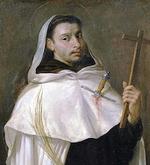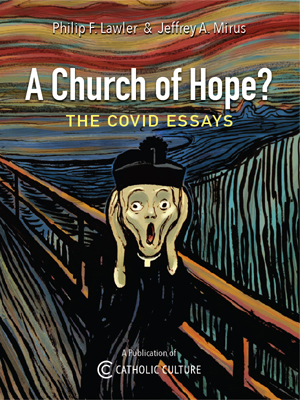Regarding Our Lady of America
by Cardinal Raymond L. Burke, D.D., J.C.D.
Dear brothers in Christ,
During the November meeting of our Conference of Bishops, you may have had occasion to view the statue of Our Lady of America, which was displayed in one of the meeting rooms; and to receive one of the Our Lady of America prayer cards or other information about Our Lady of America, which was available, thanks to the devout lay faithful who made the arrangements for the display of the statue. The faithful involved in the promotion of the devotion to Our Lady of America have asked me, some months ago, to review the history and present state of the devotion to Our Lady of America, in what pertains to its canonical status. Finally, I am able to give them a report of the results of my study, which I want also to communicate to you.
The devotion to Our Lady of America has its source in private revelations to Sister Mary Ephrem (baptized Mildred) Neuzil, who was born in 1916 and was professed, in 1933, in the Congregation of the Sisters of the Most Precious Blood of Jesus, which has its generalate in Dayton, Ohio. She later became part of a contemplative branch of the same congregation. The contemplative branch was located at Our Lady of the Nativity Convent at New Riegel, Ohio. After the suppression of the contemplative branch in 1979, the Sisters who were members took up residence in Seneca County, Ohio. From the time of the suppression, Sister Mary Ephrem used her baptismal name, Sister Mary Mildred Neuzil. Sister Mary Ephrem (Mary Mildred) died in 2000. One of the Sisters survives and continues to live in Seneca County, Ohio.
Having reviewed the correspondence between Sister Mary Ephrem and her spiritual director of many years, Monsignor Paul F. Leibold, Vicar General of the Archdiocese of Cincinnati, who later became the Bishop of Evansville and, then, Archbishop of Cincinnati, it is clear that the devotion, as proposed by Sister Mary Ephrem, received his approbation. In addition to the correspondence by which Monsignor Leibold declared the approval of the devotion, he also carried out the first of Our Lady of America's requests, made through Sister Mary Ephrem, namely, he had a medal struck with the image of Our Lady of America on one side and the coat of arms of the Christian family on the other.
The coat of arms symbolically represents the substance of the private revelation received by Sister Mary Ephrem, namely, the Indwelling of the Holy Trinity in the Christian home, which is the source of life and unity in the family. The coat of arms points to the purity and selflessness of love in the family, because of the Indwelling of the Holy Trinity, the model of which is the Mother of God, under her title of the Immaculate Conception, patroness of our nation. In a particular way, Our Lady of America expressed her desire that the United States of America, through her intercession, be devoted to the purity of love. She identified herself to Sister Mary Ephrem as "Our Lady of America, The Immaculate Virgin." In the consecration of our nation to our Blessed Mother, made in 1959 at the National Shrine and renewed, in our name, by Bishop David Ricken on November 11, 2006, the Saturday before the November meeting of our Conference of Bishops, our Blessed Mother is addressed as "Immaculate Virgin."
The contents of the private revelation received by Sister Mary Ephrem were published in a booklet, first in 1960, and, again, in 1971. Both of these editions were published with the Imprimatur of Archbishop Leibold. A final edition, with some new contents, was published in 1989. The new contents were added at the direction of Father Edmund Morman, S.V.D., the last chaplain of Our Lady of the Nativity Convent at New Reigel. Father Morman was sadly killed in an automobile accident on February 17, 1986.
As Archbishop of Cincinnati, Archbishop Leibold commissioned a wooden plaque with the image of Our Lady of America, which he gave to the cloister at New Reigel, at which it was displayed for many years in a public area. He had the wooden plaque created for the specific purpose of its use in processions at the New Reigel convent.
Archbishop Leibold also authorized the Weberding Woodcarving Shop at Batesville, Indiana, to carve a statue of Our Lady of America. The statue was carved for Our Lady of the Nativity Convent at New Reigel, Ohio, at which public devotions to Our Lady of America were regularly celebrated.
Other bishops have permitted the public display of a statue of Our Lady of America for devotion. For instance, the late Bishop William G. Connare of Greensburg permitted a statue to be displayed at the Carmel of the Assumption at Latrobe, Pennsylvania. Also, a statue of Our Lady of America was carried in procession in the Basilica of the National Shrine of the Immaculate Conception in Washington, D.C., on several occasions by the Apostolatus Uniti and other groups. On May 31, 2006, a statue of Our Lady of America was enthroned at the Shrine of the Most Blessed Sacrament and Our Lady of the Angels Monastery in Hanceville, Alabama, by the Franciscan Friars of the Immaculate. The statue which was enthroned at Hanceville is the very same statue which Bishop Connare authorized for public devotion at Latrobe.
A specific request of Our Lady of America was that her statue be placed in the Basilica of the National Shrine of the Immaculate Conception. There is a providential connection between Sister Mary Ephrem and the late Archbishop John Francis Noll of the Diocese of Fort Wayne, who is celebrated as the Apostle of the National Shrine. The principal apparitions of Our Lady of America to Sister Mary Ephrem took place in the chapel of the Precious Blood Sisters Convent in Kneipp Springs Sanitorium, near Rome City, Indiana. Archbishop Bishop Noll, who died in 1956, maintained a summer residence at the Sanitorium, within a few hundred feet of the place of the apparitions. While the National Shrine is the largest shrine in the world at which there was not a previous apparition, the private revelation to Sister Mary Ephrem very much confirms the mission of the National Shrine.
The prayer attached to the devotion also received the imprimatur of the then Monsignor Leibold, Vicar General of the Archdiocese of Cincinnati. Archbishop Leibold was Sister Mary Ephrem's spiritual director from the time that he was Vicar General of the Archdiocese of Cincinnati until he died in 1972. Archbishop Leibold was always clear that the approved devotion had its origin in private revelation received by Sister Mary Ephrem over many years.
What can be concluded canonically is that the devotion was both approved by Archbishop Leibold and, what is more, was actively promoted by him. In addition, over the years, other Bishops have approved the devotion and have participated in public devotion to the Mother of God, under the title of Our Lady of America.
Although the devotion to Our Lady of America has remained constant over the years, in recent years the devotion has spread very much and has been embraced by many with special fervor. Seemingly, as has been suggested by Father Peter Damian Mary Fehlner, F.I., in his homily of August 5, 2006, at the Shrine of the Most Blessed Sacrament in Hanceville, the moral crisis of our time, which demands a new teaching and living of the virtue of purity, has found an especially fitting response of loving care from the Mother of God in her message to Sister Mary Ephrem.
Some have raised with me the canonical question regarding the status of Our Lady of the Nativity Convent in Seneca County, Ohio, which has been the residence of any remaining member of the suppressed contemplative branch of the Congregation of Sisters of the Most Precious Blood of Jesus. In response, I observe that the canonical question has no bearing on the devotion or its approbation.
As one deeply devoted to fostering the devotion to Our Lady of Guadalupe in our nation, I have wondered about the relationship of the devotion to Our Lady of America to the devotion of Our Lady of Guadalupe. Archbishop Leibold, in fact, raised the question with Sister Mary Ephrem. Sister Mary Ephrem responded that Our Lady of Guadalupe is Empress of all the Americas, whereas "Our Lady of America, The Immaculate Virgin," is the patroness of our nation, the United States of America. The two devotions are, in fact, completely harmonious. As our late and most beloved Pope John Paul II reminded us, Our Lady of Guadalupe, Mother of America and Star of the New Evangelization, draws all of the nations of America into unity in carrying out the new evangelization. Our Lady of America calls the people of our nation to the new evangelization through a renewed dedication to purity in love.
I hope that the above may be of some help to you in responding to questions regarding the devotion to Our Lady of America.
May the Immaculate Virgin intercede for the intentions of our dioceses and our nation.
With fraternal gratitude and esteem, I remain
Yours devotedly in Christ,
(Most Rev.) Raymond L. Burke
Archbishop of Saint Louis
This item 7969 digitally provided courtesy of CatholicCulture.org






